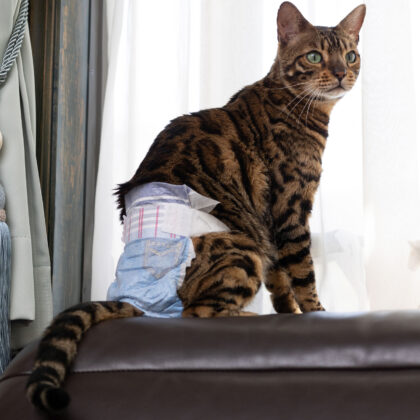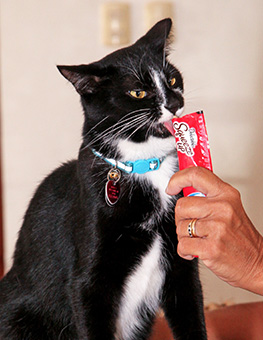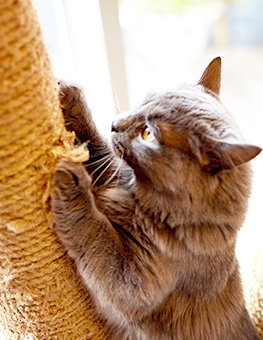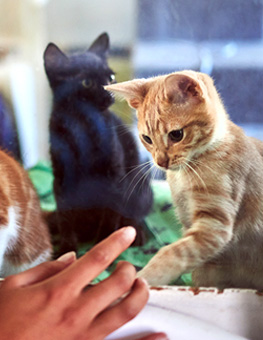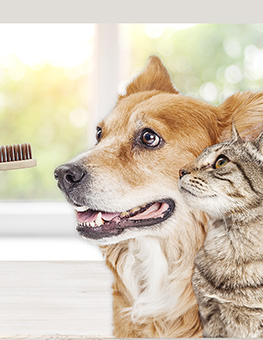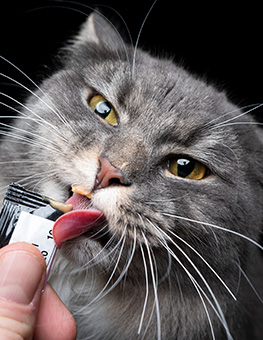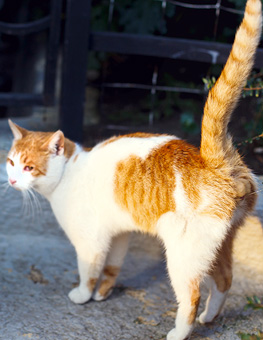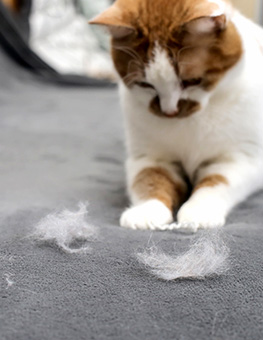Solving Your Cat’s Litter Box Problems
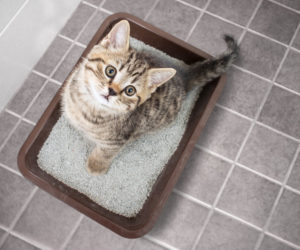
One of the most common behavioral reasons cats are surrendered to shelters is because they stop using the litter box. This is a sad statistic, because the majority of litter box issues are simple to troubleshoot and solve. With any behavior problem in cats, the best course of action is to start by asking why the cat is going outside of the litter box. Are they in pain? Are they afraid of something? Is another cat bullying them?
As a reminder, cats don’t act out of anger or spite. There is always a reason behind your cat going outside of the litter box, whether it be medical or behavioral. It’s our job as cat parents to figure out what that reason is and help our cat feel more comfortable.
What steps can we take to troubleshoot issues?
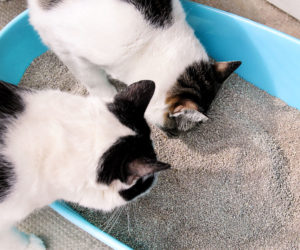
Step 1. Identify the cat
If you have multiple cats, who’s the culprit? A guilty look on your cat’s face or a gut feeling isn’t enough to place the blame. Consider setting up a nanny cam or trail cam to catch them in the act, or separate your cats into different rooms or parts of the house to try to rule one out.
If you do separate your cats and both go back to using the box, it could be stress-related from inter-cat issues. Do your cats get along? Is one bullying the other? Do you only have one litter box for two cats? You may need to add more litter boxes and work with your vet to help both cats get along.
Step 2. Take the cat to the vet
Before automatically assuming peeing outside the box is a behavioral issue, you need to make an appointment with your vet. Often, it can be the result of a painful urinary tract infection, crystals in the urine, or bladder stones. Your cat can’t tell you when something hurts, so their only way of communicating is to stop using the box. The cat may also start to associate the litter box with pain and may be looking for a place in the house where it doesn’t hurt to use the bathroom.
Step 3. Take a look at your litter box
After you’ve ruled out a medical cause, it’s time to determine if you have a litter box setup appropriate for your cat and the number of cats in your home. Starting simple, your cat may just not like the litter box! You’ll want to look at:
- Where is the litter box?
You may want to hide the litter box in a dark corner of your basement, but your cat doesn’t. It should not be in a high traffic area of your home, but it should be in an easily found and accessible place. Imagine living in a home where your bedroom was on the top floor, but your only bathroom was in the basement! - What’s in the box?
Cats, generally speaking, prefer unscented, clumping clay litter. Look for a litter that is soft on their paws, particularly if you have a senior or declawed cat. Try switching the brand or type if you’re using pellets or crystals. There are types of litter and additives that contain scents that naturally attract the cat to the litter box as well that are worth a try, but using scented litter or air fresheners around the box can deter your kitty. - What size is the box?
Many litter boxes sold in pet stores are just too small for your cat. Your cat should be able to comfortably walk in a circle inside the box. A general rule of thumb is to look for a box that is 1.5x the length of your cat. If your cat is peeing or pooping right next to the box or over the side, the size of the box is probably the problem. You can make your own litter boxes out of plastic storage totes or look for the largest one possible at the pet store. - Is the box being cleaned enough?
It should go without saying, but clean your cat’s litter box! If you’re only scooping the box once or twice a week, step it up to every day or even twice a day. Replace the litter and scrub out the box with soap and water regularly. Cats like their bathrooms to be kept squeaky clean! - Does my cat have enough litter boxes?
Believe it or not, just one litter box is never enough! You should have at least one litter box per cat in your house, plus one. This means if you have two cats, you need three litter boxes, minimum. They should be spread out in different rooms and floors of your home to make them easy to get to no matter where your cat is hanging out.
Many cats like to pee in one litter box and poop in another, so if you only have one litter box in your home, they may choose to do one or the other on the floor instead. - Is the litter box covered or uncovered?
Cats are not cave dwellers and don’t like pooping inside tiny enclosed spaces. A covered box is the equivalent of a port-a-potty for humans. They are almost always too small and can lead to problems if you have another cat in the home who is a bully. When a cat is in the litter box, they are at their most vulnerable. A covered box with only one exit traps the cat inside and makes them feel unsafe and uncomfortable.
Step 4. Evaluate fear and stress levels in your home
What if I’ve tried all the easy solutions above and nothing is working? It’s time to look at environmental reasons that could be causing your cat to feel anxious or afraid. Some of the most common are:
- Inter-cat issues can be a cause, as mentioned earlier. The litter box is seen as a resource or possession by the cat, and cats get stressed by having to share things. This may lead to one of the cats blocking access to the box for the other cat. Increasing the number of resources in your home can help alleviate the problem. Add more litter boxes, but also add more food bowls, cat trees, resting places, and toys to decrease the number of things your cats are sharing.
- A change in the home such as a new baby or pet, moving to a new house, travelling for vacation, or a new work schedule can be traumatizing for your cat, who thrives on schedule and routine. If something is different and they’re not sure how to feel about it, cats can stop using the litter box because they are worried about the change.
- Feral and outdoor cats outside the home can frequently be the culprit. Cats are territorial creatures, and they may feel the need to scent mark to warn the new cat that your house belongs to them. If you’re seeing cats outside that you haven’t before, consider trying humane deterrents or contacting your local Trap, Neuter, Return (TNR) program for help.
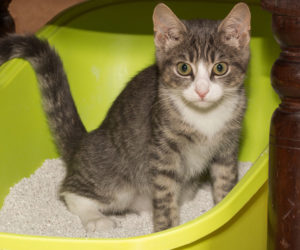
Step 5. Don’t punish your cat
Remember that cats don’t pee outside the litter box due to spite, retaliation, anger, or because they don’t like you. Cats do stop using the litter box due to fear and stress. Never punish your cat – instead, get to the root of the problem and solve it. Punishment only creates more fear and stress, which exacerbates the issue.
If you’ve determined there is an environmental cause of stress to your cat, you may want to try purchasing pheromone spray, plug-ins, or collars to help calm your cat. Behavioral medications can also be prescribed by your vet for severe stress and anxiety in your cat. Rehoming should be a last resort if your home is simply too stressful for your cat due to other pets, children, or your lifestyle.
Peeing outside the box is a communication tool from your cat to you to tell you something is wrong. It’s your job to find out what.



